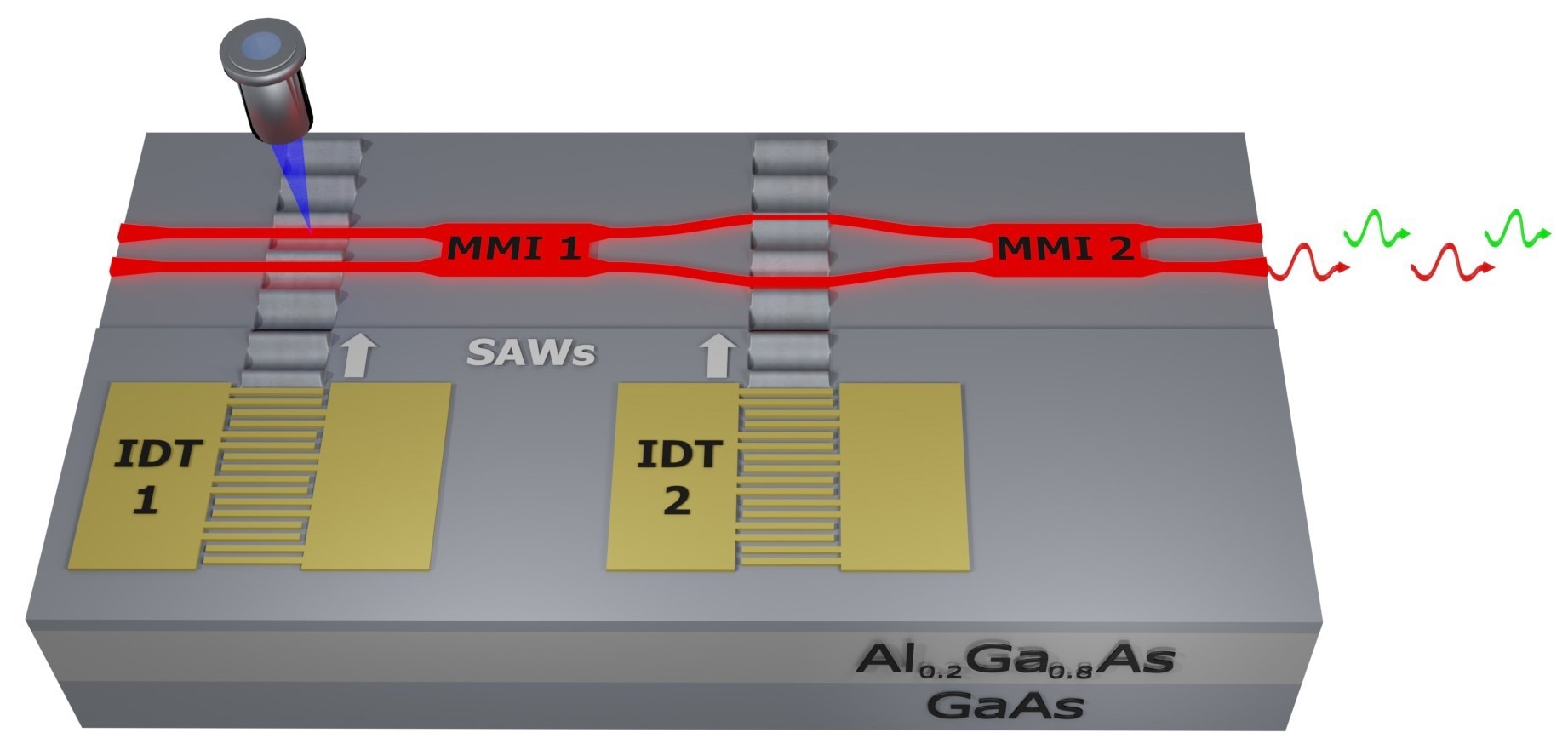A group of German and Spanish Researchers from Valencia, Münster, Augsburg, Berlin, and Munich has achieved incredibly precise control over individual light quanta.
 A focused laser beam (left, blue) generates single photos by a single quantum dot inside the photonic waveguides (red), which are fabricated on top of crystalline gallium arsenide- (GaAs-) aluminum gallium arsenide (Al0.2Ga0.8As). Two interdigitating electrodes (interdigital transducers, IDT) generate nanoscale soundwaves (surface acoustic waves, SAWs), which dynamically strain the waveguides. The nanoscale soundwave generated by the left IDT switches the color of the emitted single photons. The two waveguides are coupled by two so-called multimode interference beam splitters (MMIs). The soundwave generated by the right IDT sorts the single photons according to their color (red and green) between the two outputs on the right. Image Credit: Dominik Bühler
A focused laser beam (left, blue) generates single photos by a single quantum dot inside the photonic waveguides (red), which are fabricated on top of crystalline gallium arsenide- (GaAs-) aluminum gallium arsenide (Al0.2Ga0.8As). Two interdigitating electrodes (interdigital transducers, IDT) generate nanoscale soundwaves (surface acoustic waves, SAWs), which dynamically strain the waveguides. The nanoscale soundwave generated by the left IDT switches the color of the emitted single photons. The two waveguides are coupled by two so-called multimode interference beam splitters (MMIs). The soundwave generated by the right IDT sorts the single photons according to their color (red and green) between the two outputs on the right. Image Credit: Dominik Bühler
The researchers describe how they switch individual photons on a chip between two outputs at gigahertz frequencies using a soundwave in the journal Nature Communications. This technique, which was here first demonstrated, can now be applied to sophisticated integrated photonic networks or acoustic quantum technologies.
The technological foundation of contemporary communications is made up of light and sound waves. While nanoscale soundwaves on chips process signals at gigahertz frequencies for wireless transmission between smartphones, tablets, and laptops, the World Wide Web is created by glass fibers with laser light.
How to apply these technologies to quantum systems to create secure (i.e., tap-free) quantum communication networks is one of the most important questions for the future.
Light quanta or photons play a very central role in the development of quantum technologies. Our team has now succeeded in generating individual photons on a chip the size of a thumbnail and then controlling them with unprecedented precision, precisely clocked by means of soundwaves.
Hubert Krenner, Study Lead and Professor, Experimental Physics, University of Münster
Dr. Mauricio de Lima, who is a researcher at the University of Valencia and coordinates the work being done there, stated, “The functional principle of our chip was known to us as regards conventional laser light, but now, using light quanta, we have succeeded in making the long wished-for breakthrough towards quantum technologies.”
In their research, the scientists created a chip with minuscule “conducting paths” for light quanta or waveguides. These are roughly 30 times more delicate than human hair. Additionally, this chip included so-called quantum dots, which are quantum light sources.
These quantum dots, just a few nanometers in size, are islands inside the waveguides which emit light as individual photons. The quantum dots are included in our chip and so we don’t have to use complicated methods to generate individual photons by means of another source.
Dr. Matthias Weiß, Professor, University of Münster
The quantum chips were created by Dr. Dominik Bühler as part of his Ph.D. work at the University of Valencia. While emphasizing how quick the technology is, he stated, “By using nanoscale soundwaves, we are able to directly switch the photons on the chip back and forth between two outputs at unprecedented speed during their propagation in the waveguides.”
As a result of combining three distinct quantum systems—quantum light sources in the form of quantum dots, the produced light quanta, and phonons (the quantum particles in the soundwave)—the researchers believe their findings represent a significant step towards the development of hybrid quantum technologies.
The hybrid quantum chips, created at the Paul Drude Institute of Solid-State Electronics using quantum dots made at the Technical University of Munich, outperformed the research team’s expectations. The chips were created using a design created at the University of Valencia.
The international team has advanced acoustic quantum technologies by making another significant step.
We are already working flat out to enhance our chip so that we can program the quantum state of the photons as we wish, or even control several photons with different colors between four or more outputs.
Dr Mauricio de Lima, Researcher, University of Valencia
Prof. Hubert Krenner added, “We benefit here from a unique strength which our nanoscale soundwaves have: as these waves propagate virtually loss-free on the surface of the chip, we can neatly control almost as many waveguides as we want with just one single wave—and to an extremely high degree of precision.”
As part of the Horizon 2020 Framework Program, (Marie Skodowska Curie Grant Agreement 642688), the European Union funded the research work at the ITN SAWtrain doctoral college.
Journal References
Bühler, D. D., et al. (2022) On-chip generation and dynamic piezo-optomechanical rotation of single photons. Nature Communications. doi:10.1038/s41467-022-34372-9
Delsing, P., et al. (2019) The 2019 surface acoustic wave roadmap. Journal of Physics D: Applied Physics. doi:10.1088/1361-6463/ab1b04.